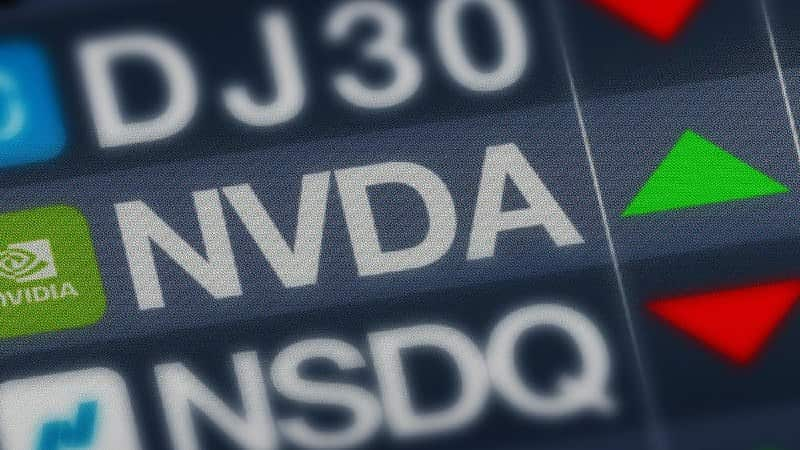Nvidia (NASDAQ: NVDA) is set to officially join the 30-member Dow Jones Industrial Average (DJIA) on Friday, November 8, replacing Intel (NASDAQ: INTC), which has held its spot in the index since 1999.
This shift, announced by S&P Dow Jones Indices after the market closed on November 1, reflects a move to align the DJIA more closely with the evolving semiconductor industry, particularly the rising prominence of artificial intelligence (AI).
For Nvidia investors, this inclusion holds substantial implications, signaling a boost in market demand and solidifying Nvidia’s standing in the tech sector.
The market responded immediately to the news, with Nvidia’s stock climbing 2.9% in after-hours trading, while Intel saw a 1.85% decline.

In addition to Nvidia’s inclusion, paint manufacturer Sherwin-Williams (NYSE: SHW) will also join the Dow, taking the place of chemical giant Dow Inc. (NYSE: DOW). These changes mark the first adjustments to the Dow since February, when Amazon (NASDAQ: AMZN) replaced Walgreens Boots Alliance (NASDAQ: WBA).
Why Nvidia is taking Intel’s spot in the DJIA
Nvidia, with a market cap of $3.39 trillion, has surged to become the second most valuable U.S. company, driven by strong demand for its AI chips.
This change comes in an extraordinary year for Nvidia, with shares up over 174%, fueled by what CEO Jensen Huang calls “insane” demand for AI solutions. Recently, Nvidia expanded its partnership with Accenture (NYSE: ACN) to further develop enterprise AI applications, positioning itself to capitalize on AI’s expanding role across industries.
In contrast, Intel, with a market cap of approximately $99 billion, has faced declining relevance in the AI space and missed critical opportunities, including passing on early investments in OpenAI, the parent company of ChatGPT.
Intel’s exit from the Dow follows years of underwhelming performance, including the slower-than-expected adoption of its Gaudi 3 AI accelerator, which fell short of its $500 million target.
This reshuffle marks another setback for Intel, once a leader in semiconductors, as its stock has dropped 52% in 2024 alone.

While Intel reported better-than-expected results in Q3 2024 and issued positive guidance, CEO Pat Gelsinger acknowledged that the company’s turnaround efforts are still in progress.
Notably, Intel recently partnered with AWS to supply custom chips for its data centers, beginning with a Xeon 6 chip built on the Intel 3 process.
This will be followed by an AI fabric chip on the advanced 18A process, designed to be compatible with TSMC’s 2nm technology, which is slated for commercial release in 2025.
“By co-developing next-generation AI fabric chips on Intel 18A, we continue our long-standing collaboration, dating back to 2006 when we launched the first Amazon EC2 instance featuring their chips. Our continued collaboration allows us to empower our joint customers with the ability to run any workload and unlock new AI capabilities.”-Matt Garman, CEO at AWS
However, Intel’s exit from the Dow may dampen investor sentiment, posing an additional challenge as the company pursues its recovery.
What the change means for investors
Nvidia’s inclusion in the DJIA paves the way for broader exposure through mutual funds and ETFs that track the index, likely boosting demand for NVDA shares.
Historically, stocks added to the Dow experience a demand boost, as institutional and retail investors adjust their portfolios to reflect the change. Given Nvidia’s robust growth trajectory, its entry into the Dow could further strengthen investor confidence, potentially creating upward pressure on the stock.
Moreover, Nvidia’s recent 10-for-1 stock split in June enabled its entry into the price-weighted Dow, making the stock more accessible to retail investors while ensuring that it wouldn’t overly skew the index.
Trading at $135.37 as of Friday’s close, Nvidia’s stock is now set to effectively represent the modern semiconductor industry within the Dow without disproportionately impacting its movement.
Conversely, Intel’s removal from the Dow may reduce demand for its stock, as ETFs and mutual funds tracking the DJIA adjust their holdings. This comes at a challenging time for Intel, as its stock has already fallen substantially this year.
Nvidia’s growth outlook amid demand uncertainty
With Nvidia’s earnings report on November 20 approaching, investors are focused on its strong demand for AI chips, a key growth catalyst this year.
However, financial struggles at Super Micro Computer Inc. (NASDAQ: SMCI) could impact Nvidia’s revenue if SMCI reduces or suspends orders completely, curbing demand.
Additionally, Nvidia’s inclusion in the Dow Jones Industrial Average further elevates its profile, likely increasing exposure and interest from institutional and retail investors alike.
While the Dow entry could bolster Nvidia’s stock in the near term, investors will be closely watching the earnings report to gauge if Nvidia’s momentum can continue amid evolving demand dynamics and SMCI’s struggles.









